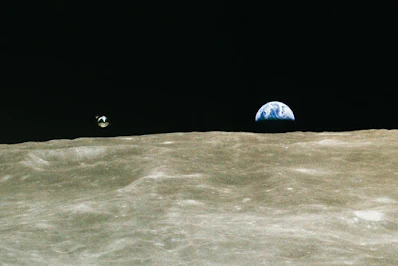The Apollo space program was probably the most important space travel to have ever taken place and that's including Uri Gagarin's first man on a space mission.
Video
I'm not going to go through all the space missions or programs because there are way too many and that's not even including the top-secret missions to space. So, I'm going to be picking Apollo 16. It's been 50 years, yesterday 16th April.
Why Apollo 16, because it's the best one!
Apollo 16 Lunar spacecraft: Orion (left) and Casper (right)
Credit: NASA/UFO Sighting's Footage.
A crescent Earth rises above the Moon as seen from the lunar module, with Casper in the distance.
Credit: NASA.
The Apollo astronauts could have come into a lot of trouble if wasn't for the quick thinking of ground control and the astronauts.
Yesterday marked the 50th anniversary of humanity’s fifth crewed lunar launch - the highly successful and fascinating Apollo 16.
Launched on April 16th, 1972, and returning to Earth 11 days later, Apollo 16 was commanded by John Young. He and his lunar module pilot Charles (Charlie) Duke spent three days on the Moon’s surface. Command and service module pilot Ken Mattingly stayed in lunar orbit, performing experiments.
Related Post
Ancient Alien Moon Structure From The Apollo Mission Reels
On April 16, 1972, the sixth manned lunar landing mission, Apollo 16, launched from Kennedy Space Center, Fla. on its way to conduct scientific investigations on the Moon’s Descartes highlands. The mission was also the first usage of the Moon as an astronomical observatory with the use of the ultraviolet camera/spectrograph which photographed ultraviolet light emitted by Earth and other celestial objects. In this photo taken by lunar module pilot Charles M. Duke, commander of the Apollo 16 lunar landing mission, John W. Young, salutes the United States flag during the mission’s first extravehicular activity. Both the Lunar Module (LM) "Orion" and the Lunar Roving Vehicle (LRV) can be seen in the background. NASA’s Marshall Space Flight Center in Huntsville, Ala. held overall responsibility for both the Saturn V launch vehicle and the LRV.
The Apollo Moon mission wasn't without its problems. There were two problems which happened. One problem happened on the way to the Moon and another one was on the way back to Earth.
Problem number 1.
Shortly before the lunar landing, Mattingly noticed a problem with the command module’s steerable engine. Young and Duke were already in the undocked (separated) lunar module, so the two spacecraft waited together in lunar orbit while ground crews in Houston examined the issue. The looming possibility of a landing abort led Mattingly to famously remark, "I will be a sorry bird."
Credit: NASA.
Related Post
China's Yutu-2 Rover Spots Cube On the Far Side Of The Moon
Problem number 2.
After docking with Casper, the crew began to transfer gear between spacecraft, but they unintentionally brought some lunar dust in, too.
"The command module filled up with LM dust and rocks and things almost immediately," Mattingly recalled. "Within an hour, it was very noticeable that there was a coating of dust on all the instrument panels and all the surfaces. You'd see little rocks float by in front of your nose. I was surprised how rapidly that stuff all had diffused in. It came over as soon as we brought the first bag the first suit, or whatever it was. That stuff was just coming off of everything and it never stopped."
UFO Sighting's Footage is your first place to get up-to-date information on Ufology knowledge and understanding of the Extraterrestrial kind
Related Post
Huge UFO Fleet In Formation Flying Past The Moon I've Counted 30
Apollo Moon mission "everything you need to know".
Crew
John W. Young, Commander
Charles M. Duke Jr., Lunar Module Pilot
Thomas K. Mattingly II, Command Module Pilot
Backup Crew
Fred Haise, Commander
Edgar D. Mitchell, Lunar Module Pilot
Stuart A. Roosa, Command Module Pilot
Payload
Casper (CM-113)
Orion (LM-11)
Prelaunch Milestones
7/1/70 - S-IVB on dock at Kennedy
9/17/71 - S-IC on the dock at Kennedy
9/29/70 - S-IU on the dock at Kennedy
9/30/70 - S-II on the dock at Kennedy
Launch
April 16, 1972; 12:54:00:567 p.m. EST
Launch Pad 39A
Saturn-V SA-511
High Bay 3
Mobile Launcher Platform-3
Firing Room 1
Orbit
Altitude: 107.5 miles
Inclination: 32.54 degrees
Orbits: 64 revolutions
Duration: 11 days, one hour, 51 minutes
Surface Time: 71:02:13
Distance: 1,391,550 miles
Lunar Location: Descartes Highlands
Lunar Coordinates: 8.97 degrees south, 15.51 degrees east
Landing
April 27, 1972
Pacific Ocean
Recovery Ship: USS Ticonderoga
Mission Objective
Three primary objectives were (1) to inspect, survey, and sample materials and surface features at a selected landing site in the Descartes region; (2) to emplace and activate surface experiments; and (3) to conduct in-flight experiments and photographic tasks from lunar orbit. Additional objectives included the performance of experiments requiring zero gravity and engineering evaluation of spacecraft and equipment.
Related Post
Lots Of UFOs On The Edge Of Craters On The Moon's Dark Side
The Descartes landing site is in a highlands region of the moon's southeast quadrant, characterized by hilly, grooved, furrowed terrain. It was selected as an outstanding location for sampling two volcanic construction units of the highlands – the Cayley Formation and the Kant Plateau. The Apollo Lunar Surface Experiments Package, or ALSEP, was the fourth such station to become operational after Apollos 12, 14 and 15.
Here's an Apollo 16 Lunar Grand Prix video above, enjoy:
Please can you share this post, cheers. And don't forget to share your thoughts and opinions on this, thank you.{alertInfo}
Credit: NASA/Sky And Telescope/UFO Sighting's Footage/NASA/Ufosfootage/Canva.





